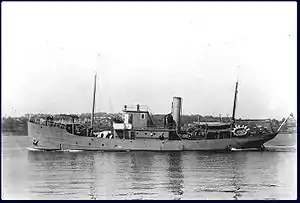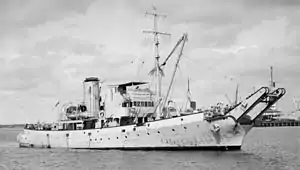Net laying ship
A net laying ship, also known as a net layer, net tender, gate ship or boom defence vessel was a type of naval auxiliary ship.

A net layer's primary function was to lay and maintain steel anti-submarine nets or anti torpedo nets. Nets could be laid around an individual ship at anchor, or harbor entrances or dry docks, or other anchorages. Net laying was potentially dangerous work, and net laying seamen were experts at dealing with blocks, tackles, knots and splicing. As World War II progressed, net layers were pressed into a variety of additional roles including salvage, troop and cargo transport, buoy maintenance, and service as tugboats.[1]
US Navy
1930s
War Plan Orange, the pre-WW2 US plan for war with Japan, anticipated that Pearl Harbor would be too small for the US Navy fleet that would be amassed in Hawaii. Orange anticipated the construction of a large anchorage in Lahaina Roads between the islands of Maui, Lānaʻi, and Molokaʻi. Construction would consist of massive nets and minefields to protect the anchored ships.[2]
Ultimately four large netlayers would be laid down just before and after the attack on Pearl Harbor: USS Monitor (AN-1), USS Montauk (AN-2), USS Osage (AN-3), and USS Saugus (AN-4).[A 1] It turned out that these ships were not needed. First, dredging significantly enlarged the anchorages in Pearl Harbor. Second, the mobility of aircraft carrier warfare made the large Lahaina Roads anchorage concept obsolete, though smaller nets would still be needed for the entrance channels at advanced bases such as the Naval Base Majuro and Naval Base Ulithi. Third, new technology resulted in lightweight nets that could be handled by smaller vessels. The four large netlayers would be converted to carry and launch amphibious vehicles under the hull classification Landing Ship, Vehicle (LSV).[3]
1940s
| General characteristics of US Navy Aloe-class net laying ship | |
| Displacement: | 560 tons, 700 tons laden |
| Length: | 151 ft. 8 in. |
| Beam: | 30 ft. 6 in. |
| Draft: | 10 ft. 6 in. |
| Speed: | 14 knots |
| Propulsion: | Diesel, single screw |
| Complement: | 40 |
| Armament: | 1 x 3"/50 caliber dual purpose gun, 3 x 20mm mounts |
Small net layers initially received the hull classification symbol Yard Net Tenders (YN) but 77 were later reclassified as Auxiliary Net Layer Ships (AN). These vessels had two prominent steel "horns" on the bow, used in laying nets. Another 24 vessels which held the (YN) symbol were impressed tugs rather than specially-built craft, and so these were redesignated as Net Tender Tugs (YNT).
The 77 small Auxiliary Net Layers were built in three classes. The first 32, the Aloe-class, were all launched in 1940 (before the attack on Pearl Harbor) and were built of steel. Due to the chronic shortage of steel during the war, the next 40, the Ailanthus-class, were built of wood. The last 15, the Cohoes-class, laid down in 1944 and 1945, were again constructed of steel.[4]
These vessels served in all theatres of war but particularly in the Pacific. Many of the ships were decommissioned after the war, but some continued in service for several more decades. Net layers were eventually made redundant by advances in underwater detection technology.[5]
There were also at least 43 craft that were classed as Net Gate Craft (YNG); many were simply powered barges.[2]
To transport nets and to otherwise support the net layers, by 1943 specially built cargo ships, designated Net Cargo Ships (AKN), were built. The first of this class was the USS Indus (AKN-1). The Indus worked in Naval Base Philippines.[6][7] Finally in 1946, the USS Montauk would be converted back from an LSV to net cargo duties as the USS Galilea (AKN-6).
British and Commonwealth
The United Kingdom and British Commonwealth referred to Net laying ship as “boom defence vessel".[8][9]
- Bar-class boom defence vessel built in the 1940s.
- Net-class boom defence vessel built in the 1930s.
Gallery
 The boom defence net at Scapa Flow being towed into position by two Royal Navy boom defence vessels in 1943.
The boom defence net at Scapa Flow being towed into position by two Royal Navy boom defence vessels in 1943. At Scapa Flow, a Royal Navy net laying vessel prepares to lay an anti-submarine net, which is 900 feet (275 metres) long, weighs over 40 Imperial tons (41 tonnes) and could be laid in 4 minutes.
At Scapa Flow, a Royal Navy net laying vessel prepares to lay an anti-submarine net, which is 900 feet (275 metres) long, weighs over 40 Imperial tons (41 tonnes) and could be laid in 4 minutes. HMS Rogate, a Royal Navy "gate vessel" designed to open and close the boom and nets at Portsmouth Harbour during World War II.
HMS Rogate, a Royal Navy "gate vessel" designed to open and close the boom and nets at Portsmouth Harbour during World War II. HMCS Ypres was a Battle class trawler used by the Royal Canadian Navy as a gate vessel. She was sunk in a collision with a battleship in May 1940.
HMCS Ypres was a Battle class trawler used by the Royal Canadian Navy as a gate vessel. She was sunk in a collision with a battleship in May 1940..jpg.webp) The US Navy wooden Net Tender, USS Terebinth (AN-59) in wartime camouflage.
The US Navy wooden Net Tender, USS Terebinth (AN-59) in wartime camouflage.
 USS Montauk after completion of her LSV conversion (mostly internal).
USS Montauk after completion of her LSV conversion (mostly internal).
See also
- List of auxiliaries of the United States Navy § Net Cargo Ships (AKN)
- List of auxiliaries of the United States Navy § Net Laying Ships (AN)
- List of yard and district craft of the United States Navy § Yard Net Tenders (YN)
- List of yard and district craft of the United States Navy § Net Gate Craft (YNG)
- List of yard and district craft of the United States Navy § Net Tender Tugs (YNT)
- US Naval Advance Bases
- Wooden boats of World War II
References
Citations
- Friedman, Norman (2002). U.S. Amphibious Ships and Craft: An Illustrated Design History. Annapolis, Maryland: United States Naval Institute. ISBN 1-55750-250-1.
- Miller, Edward S. (1991). War Plan Orange: The U.S. Strategy to Defeat Japan, 1897–1945. Annapolis, MD: United States Naval Institute Press. ISBN 1-59114-500-7.
- Friedman, 2002, pp 178-179
- Jurens, W. (2016). "Life in the Slow Lane: Some Thoughts on Minelayer and Netlayer Evolution". Warship International. LIII (1): 59–68. ISSN 0043-0374.
- World War II Net Tenders, Navsource Online.
- USS Indus (AKN-1)US Navy
- USS Indus (AKN-1), Net Tender Storynavsource.org
- Richard Pelvin with Robert Darby. "Australian War Memorial : Know your warships!, Page 67" (PDF). www.awm.gov.au. Archived from the original (PDF) on 10 April 2008. Retrieved 21 September 2010.
- Boom defence vessel uboat.net
Footnotes
- These ships were of a common design with three fleet minelayers: USS Terror (CM-5), USS Catskill (CM-6), and USS Ozark (CM-7) which are listed here